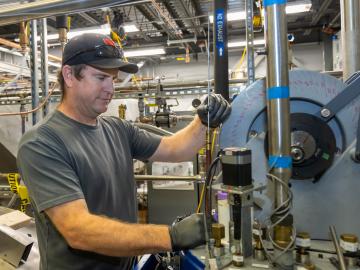Filter News
Area of Research
- Advanced Manufacturing (2)
- Biology and Environment (13)
- Clean Energy (50)
- Computational Biology (1)
- Computer Science (1)
- Electricity and Smart Grid (1)
- Energy Sciences (1)
- Functional Materials for Energy (2)
- Fusion and Fission (5)
- Isotopes (16)
- Materials (34)
- Materials for Computing (3)
- National Security (9)
- Neutron Science (9)
- Nuclear Science and Technology (5)
- Quantum information Science (1)
- Supercomputing (12)
News Type
News Topics
- (-) Biomedical (23)
- (-) Cybersecurity (15)
- (-) Energy Storage (61)
- (-) Isotopes (20)
- (-) Physics (27)
- (-) Space Exploration (11)
- 3-D Printing/Advanced Manufacturing (60)
- Advanced Reactors (20)
- Artificial Intelligence (24)
- Big Data (23)
- Bioenergy (36)
- Biology (44)
- Biotechnology (6)
- Buildings (33)
- Chemical Sciences (27)
- Clean Water (19)
- Climate Change (41)
- Composites (15)
- Computer Science (67)
- Coronavirus (21)
- Critical Materials (14)
- Decarbonization (25)
- Environment (93)
- Exascale Computing (6)
- Frontier (6)
- Fusion (24)
- Grid (30)
- High-Performance Computing (31)
- Hydropower (8)
- Irradiation (3)
- ITER (5)
- Machine Learning (16)
- Materials (75)
- Materials Science (65)
- Mathematics (4)
- Mercury (7)
- Microscopy (29)
- Molten Salt (6)
- Nanotechnology (30)
- National Security (25)
- Net Zero (3)
- Neutron Science (49)
- Nuclear Energy (48)
- Partnerships (6)
- Polymers (18)
- Quantum Computing (7)
- Quantum Science (16)
- Security (10)
- Simulation (15)
- Software (1)
- Statistics (1)
- Summit (10)
- Sustainable Energy (65)
- Transformational Challenge Reactor (1)
- Transportation (57)
Media Contacts

Associate Technician Sean Hollander is the keeper of the Fundamental Neutron Physics Beamline, which is operated by the Physics Division at the Spallation Neutron Source at ORNL, where scientists use neutrons to study all manner of matter.

ORNL scientists develop a sample holder that tumbles powdered photochemical materials within a neutron beamline — exposing more of the material to light for increased photo-activation and better photochemistry data capture.

An international team using neutrons set the first benchmark (one nanosecond) for a polymer-electrolyte and lithium-salt mixture. Findings could produce safer, more powerful lithium batteries.

Two different teams that included Oak Ridge National Laboratory employees were honored Feb. 20 with Secretary’s Honor Achievement Awards from the Department of Energy. This is DOE's highest form of employee recognition.

Chelsea Chen, a polymer physicist at ORNL, is studying ion transport in solid electrolytes that could help electric vehicle battery charges last longer.

Electric vehicles can drive longer distances if their lithium-ion batteries deliver more energy in a lighter package. A prime weight-loss candidate is the current collector, a component that often adds 10% to the weight of a battery cell without contributing energy.

It would be a challenge for any scientist to match Alexey Serov’s rate of inventions related to green hydrogen fuel. But this researcher at ORNL has 84 patents with at least 35 more under review, so his electrifying pace is unlikely to slow down any time soon.


Michael McGuire’s recognition as the Oak Ridge National Laboratory's top scientist headlined the annual awards. ORNL Director Stephen Streiffer also presented Director’s Awards to two teams, for operational performance and continuous improvement, and to the night’s science communicator awardee

Hilda Klasky, an R&D staff member in the Scalable Biomedical Modeling group at ORNL, has been selected as a senior member of the Association of Computing Machinery, or ACM.




